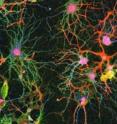Process leading to protein diversity in cells important for proper neuron firing
Related images
(click to enlarge)
Cells have their own version of the cut-and-paste editing function called splicing. Researchers at the University of Pennsylvania School of Medicine have documented a novel form of splicing in the cytoplasm of a nerve cell, which dictates a special form of a potassium channel protein in the outer membrane. The channel protein is found in the dendrites of hippocampus cells -- the seat of memory, learning, and spatial navigation -- and is involved in coordinating the electrical firing of nerve cells. Dendrites, which branch from the cell body of the neuron, play a key role in the communication between cells of the nervous system. The diversity of proteins within the human body -- in this case neurons – arises from the many ways that messenger RNAs (mRNA) can be spliced and reconnected. To start, a gene is copied into mRNA, which contains both exons (protein-coding regions) and introns (non-coding regions). Special molecules cut out introns and merge together the remaining exon pieces, resulting in an mRNA capable of being translated into a specific protein.
The study, published this week online in the Proceedings of the National Academy of Sciences, is the first to show that introns that are retained in mRNA can direct the choice of protein sequences to be included in the final protein prior to translation into a full protein. Normally introns would be spliced out in the nucleus. Diseases such as epilepsy that are based on electrical misfiring in the brain could be targets of manipulation of such cytoplasmic splicing.
In a series of previously published research, the lab of senior author James Eberwine, PhD, established that splicing of RNA occurs outside of the nucleus in different parts of a nerve cell, specifically in the cytoplasm and dendrites. Eberwine is the Elmer Holmes Bobst professor of Pharmacology and co-director of the Penn Genome Frontiers Institute.
The group went on to discover that retained introns are necessary to produce a functional ion channel called BKCa in the dendrite. BKCa channels need to have these introns spliced out in the cytoplasm to work correctly. Introns were once thought of as junk DNA, but are now being shown to exert important regulatory control. Indeed, in some cases mutations in introns are responsible for causing disease, while in previous work Eberwine and colleagues were able to show that a retained intron is responsible for proper cellular localization of the final translated protein.
One particular intron, i17a, is found next to a portion of the BKCa protein, called the STREX domain. When STREX is in the channel protein BKCa, physiological properties such as burst firing and action potential change. These are important bio-electrical actions governing how nerve cells communicate with each other.
For the STREX domain to be part of the larger BKCa protein, i17a has to be removed in the cytoplasm. If i17a isn't spliced out in the cytoplasm very little STREX-containing BKCa protein is made. This leads to a poorly functioning neuron.
Diseases such as epilepsy that are based on electrical misfiring in the brain could be targets of manipulating cytoplasmic splicing to control how much STREX-containing BKCa protein is made and ultimately available in a neuron cell membrane. The diversity in splicing allows for different types of protein to be made, including the STREX-containing protein. In turn, other proteins are then able to bind to the channel, which in turn leads to other molecular events necessary for correct nerve firing.
The generality of this phenomena is being investigated with the goal being to understand this form of cellular regulation such that it can be experimentally manipulated in a directed and meaningful manner.
Source: University of Pennsylvania School of Medicine
Other sources
- Process leading to protein diversity in cells important for proper neuron firingfrom Science DailyThu, 18 Nov 2010, 19:22:28 UTC
- Process leading to protein diversity in cells important for proper neuron firingfrom Science BlogThu, 18 Nov 2010, 16:50:36 UTC
- Process leading to protein diversity in cells important for proper neuron firingfrom PhysorgWed, 17 Nov 2010, 21:20:17 UTC
